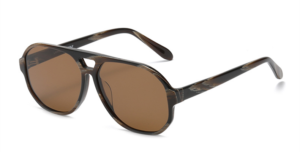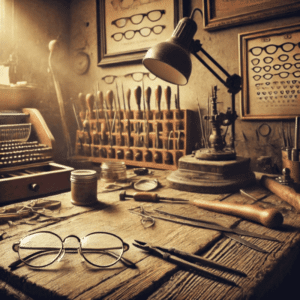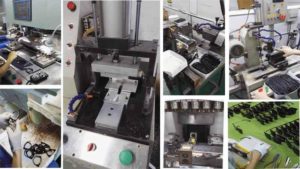Introduction
In the world of eyewear, craftsmanship transforms an accessory into an iconic statement. While eyewear serves essential functions like vision correction and eye protection, it also symbolizes personal style, cultural identity, and professional standing. For professionals in the eyewear industry, understanding what elevates a frame from ordinary to extraordinary is crucial. This article explores the art and science behind exceptional craftsmanship, uncovering the materials, techniques, and trends that define high-quality eyewear.
A Historical Perspective
The history of eyewear dates back to ancient times, with early examples found in 13th-century Italy. Initially, eyewear was a purely functional item—a means to improve vision. However, as the centuries progressed, eyewear evolved into a fusion of function and fashion. By the 18th and 19th centuries, frames were being crafted with greater attention to design and detail, signaling a shift toward luxury and personal expression.
Significant milestones in the history of eyewear include the transition from simple wire frames to more elaborate materials such as tortoiseshell and horn. The mid-20th century saw the rise of acetate as a popular material, offering new possibilities for color and shape. Each era brought innovations that expanded the boundaries of eyewear craftsmanship.
Materials that Make the Difference
Natural Materials
 Acetate: One of the most widely used materials in high-quality eyewear, acetate is prized for its durability and vibrant color options. Derived from cotton and wood fibers, acetate can be shaped and polished to create frames that are both strong and lightweight. Its versatility allows for endless design possibilities.
Acetate: One of the most widely used materials in high-quality eyewear, acetate is prized for its durability and vibrant color options. Derived from cotton and wood fibers, acetate can be shaped and polished to create frames that are both strong and lightweight. Its versatility allows for endless design possibilities.
Horn: Genuine horn frames, often made from buffalo or ox horn, are known for their unique texture and warmth. No two horn frames are identical, making them a favorite among luxury eyewear enthusiasts. The natural grain and slight imperfections add character and individuality to each piece.
Wood: Although less common, wood frames offer a distinctive, eco-friendly alternative. These frames are often handcrafted and appeal to those seeking sustainability and natural aesthetics.
Metal Options
 Titanium: Lightweight, hypoallergenic, and incredibly strong, titanium is a top choice for high-performance eyewear. It offers a sleek, modern look and is often used in minimalist designs.
Titanium: Lightweight, hypoallergenic, and incredibly strong, titanium is a top choice for high-performance eyewear. It offers a sleek, modern look and is often used in minimalist designs.
Stainless Steel: Known for its durability and corrosion resistance, stainless steel is a reliable option for everyday wear. It strikes a balance between strength and flexibility, making it suitable for various frame styles.
Aluminum: While less common, aluminum frames are valued for their lightweight nature and modern aesthetic. They are often anodized to enhance durability and color vibrancy.
Innovative and Sustainable Materials
The demand for eco-friendly eyewear has led to the exploration of sustainable materials such as recycled plastics, biodegradable acetate, and plant-based alternatives. Brands committed to sustainability are pushing the boundaries of traditional craftsmanship while reducing their environmental footprint.
Design and Functionality
Great eyewear is not just about aesthetics—it’s about finding the perfect balance between design and functionality. Modern frame designs prioritize ergonomics, ensuring a comfortable fit for extended wear. Customization is increasingly popular, with many brands offering bespoke options to cater to individual preferences.
Trends in frame design are constantly evolving, influenced by fashion, technology, and cultural movements. While bold, oversized frames may dominate one season, minimalist and wire-frame styles might take center stage the next. Regardless of trends, the foundation of good design remains rooted in craftsmanship and attention to detail.
The Craftsmanship Process
Creating a pair of high-quality eyewear frames is a meticulous process that combines traditional techniques with modern technology. It begins with design and prototyping, where concepts are sketched and refined before being brought to life.
In handmade eyewear, artisans carefully cut, shape, and polish each frame by hand. This labor-intensive process ensures precision and quality at every step. Unlike mass-produced frames, handmade pieces often undergo multiple rounds of inspection and refinement.
Modern technology has also enhanced the craftsmanship process. Techniques such as CNC machining and laser cutting allow for greater accuracy and consistency, while 3D printing opens up new possibilities for innovative designs.
Spotlight on Master Artisans
The world of eyewear is home to master artisans whose dedication and skill set them apart. These individuals often come from generations of craftsmen, passing down techniques honed over decades. Some of the most renowned eyewear houses are still family-owned, preserving the tradition of artisanal craftsmanship while embracing modern innovation.
Highlighting the stories of these artisans not only brings attention to their craft but also underscores the human element behind every frame. Each piece tells a story, reflecting the passion and expertise of the artisan who created it.
Technology Meets Tradition
The intersection of technology and tradition has revolutionized eyewear craftsmanship. While traditional handcrafting techniques remain essential, technology has introduced efficiencies and possibilities that were once unimaginable.
3D printing, for example, allows designers to experiment with complex shapes and structures without the limitations of traditional methods. Laser cutting ensures precise detailing, while advanced coating technologies enhance durability and scratch resistance.
Despite these advancements, the essence of craftsmanship remains unchanged. Technology is a tool—a means to elevate the craft, not replace it.
Recognizing Quality in Eyewear
For professionals in the eyewear industry, the ability to recognize quality is paramount. A well-crafted frame is defined by its materials, construction, and finish. Here are some key aspects to consider:
- Materials: High-quality materials not only look better but also last longer. Look for frames made from premium acetate, titanium, or genuine horn.
- Construction: Pay attention to the joints and hinges. Smooth, sturdy connections indicate a higher level of craftsmanship.
- Finish: The finish should be flawless, with no rough edges or uneven surfaces. Polishing and detailing are signs of care and precision.
Sustainability and the Future of Eyewear Craftsmanship
As sustainability becomes increasingly important, the eyewear industry is adapting. Many brands are adopting eco-friendly practices, from sourcing sustainable materials to implementing energy-efficient production processes. Consumers are also becoming more conscious of the environmental impact of their choices, driving demand for ethical and sustainable products.
The future of eyewear craftsmanship lies in the balance between tradition and innovation. By embracing new materials and technologies while preserving the art of handcrafting, the industry can continue to evolve and thrive.
Conclusion
Craftsmanship is the heart and soul of exceptional eyewear. It’s what sets apart a mass-produced frame from a piece of art. For professionals in the eyewear industry, understanding the secrets behind craftsmanship—from materials to techniques—is key to recognizing and creating high-quality frames.
As the industry moves forward, the fusion of tradition and technology will shape the future of eyewear. Yet, at its core, the essence of craftsmanship will always remain: a dedication to quality, detail, and the pursuit of excellence.




